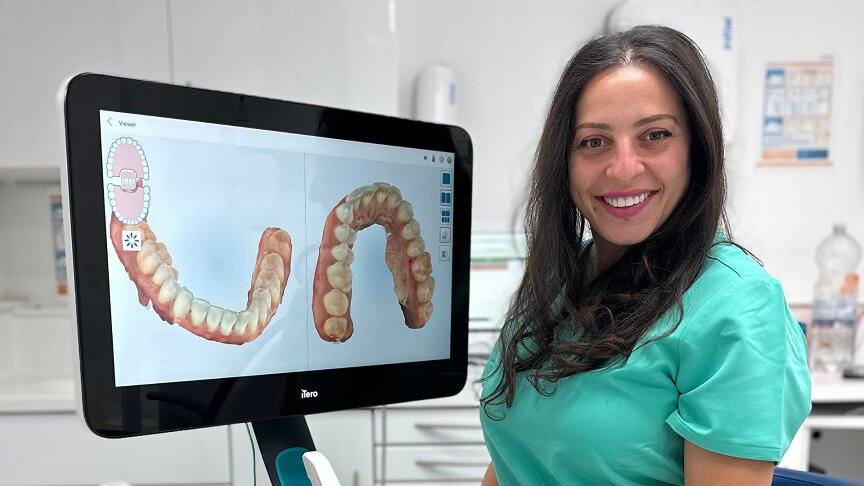Introduction
A beautiful, even smile can significantly boost confidence and self-esteem. Veneers have become a popular cosmetic dental solution for achieving that perfect smile. These thin, custom-made shells cover the front surface of teeth to improve colour, shape, alignment and overall aesthetics.
One of the most common questions patients ask is: “Do you get veneers on every tooth?”
The answer is generally no. Most patients only require veneers on the teeth that are visible when smiling — usually the upper front six to ten teeth. However, the exact number varies depending on individual dental health, smile aesthetics, and personal goals.
This comprehensive guide explores:
- How many veneers people typically get
- Factors influencing veneer placement.
- Partial vs full-mouth veneers.
- Common misconceptions about veneers
- Long-term care and maintenance.
- How to ensure veneers look natural and last for years.
💡 At Whites Dental, our expert veneers dentists Central in London at both Waterloo and Marble Arch locations help patients achieve their dream smile safely and effectively.
Key Takeaway
- Most patients do not need veneers on every tooth — treatment usually focuses on visible front teeth.
- The number of veneers depends on smile line, tooth health, bite alignment, and cosmetic goals.
- Partial veneer treatment is often more natural, less invasive and cost-effective.
- Full-mouth veneers are reserved for patients requiring extensive cosmetic correction
- Professional consultation is essential to customise veneer placement and maintain dental health.
What Are Veneers And How Do They Work?
Veneers are ultra-thin, custom-made medical grade shells designed to cover the front surface of a patients teeth. They can correct:
- Stains or discoloration
- Minor chips, cracks, or fractures
- Slightly misaligned or uneven teeth
- Gaps between teeth
- Teeth that are worn down or irregularly shaped
Veneers are made from high-quality materials such as:
- Porcelain – durable and natural-looking
- Emax – highly translucent and strong
- Lumineers/No-Prep Veneers – ultra-thin, require minimal tooth preparation
- Composite veneers – faster to apply – also more affordable than other types of veneers
💡 Dental veneers enhance the aesthetics of your smile without significantly altering the structure of the teeth. At Whites Dental, each veneer is custom-crafted to match the colour, shape and translucency of your natural teeth for a seamless smile.
Do You Get Veneers On Every Tooth?

Partial Veneer Treatment: The Most Common Approach
Most patients only get veneers on the teeth visible when smiling. This usually includes:
- Upper front six to ten teeth: central incisors, lateral incisors, canines, and occasionally first premolars
- Sometimes lower front teeth if they are prominently visible during speech or smiling
Benefits of Partial Veneer Placement:
- Less invasive – minimal enamel removal from healthy teeth
- Cost-effective – fewer veneers reduce overall treatment costs
- Natural aesthetics – only visible teeth are enhanced
- Shorter treatment time – fewer teeth to prepare, bond, and adjust
💡 At Whites Dental Waterloo and Marble Arch, dentists use digital smile design to determine which teeth will benefit most from veneers, ensuring a balanced and harmonious appearance.
Full-Mouth Veneer Treatment: When Is It Needed?
Full-mouth veneers are less common but may be recommended in cases of:
- Severe discoloration affecting most teeth
- Widespread wear, erosion, or damage due to bruxism or acid reflux;
- Significant misalignment that cannot be corrected with minor veneers
- Desire for complete smile transformation
Full-mouth veneers involve applying veneers to nearly all upper and lower teeth. While this can create a flawless smile, it is:
- More invasive – requires extensive enamel removal.
- Costlier – more veneers, lab work, and dentist time
- Higher maintenance – increased risk of wear or bonding issues if not cared for properly
💡 Professional planning is crucial to maintain bite alignment, chewing function, and long-term durability.
Factors Determining How Many Veneers You Need
Smile Line Visibility
The number of veneers is largely determined by which teeth are visible when you smile:
- Short smile line: only a few upper teeth show
- Broad smile line: more teeth show when speaking or laughing
💡 Digital imaging helps dentists map the smile line and decide the number of veneers needed for natural aesthetics.
Tooth Condition And Health
- Teeth with chips, discoloration, or minor misalignment are prime candidates for veneers
- Teeth that are healthy and aesthetically acceptable may remain untouched
- Teeth with decay, large fillings, or fractures may require crowns instead.
💡 Ensuring healthy teeth and gums before placing veneers is essential for long-term success.
Bite And Function
The number of veneers also depends on bite function:
- Incorrectly placed veneers can affect chewing efficiency
- Poor planning may cause jaw misalignment
- Dentists assess occlusion (how teeth meet) to determine optimal veneer placement
Cosmetic Goals And Expectations
Patients’ aesthetic goals influence how many veneers they receive:
- Subtle enhancement: 2–4 veneers on most visible teeth
- Balanced smile: 6–10 veneers for front upper teeth
- Full makeover: 10–20 veneers including upper and sometimes lower teeth
Common Scenarios And Veneer Numbers

- Minor Stains or Chips: Usually 2–4 veneers on the most visible teeth
- Uneven Smile With Multiple Imperfections: 6–8 veneers for a balanced appearance
- Full Smile Makeover: 10–20 veneers, upper and lower teeth
💡 Partial veneers allow for a natural look while improving the smile without unnecessary treatment.
Benefits Of Partial Veneer Placement
- Less Invasive: Minimal removal of healthy enamel.
- Cost-Effective: Fewer veneers mean reduced expense
- Natural Aesthetics: Only enhance visible teeth for a seamless smile.
- Shorter Treatment Time: Fewer teeth to prepare and bond.
- Customisable: Dentists can focus on teeth that need cosmetic improvement
Risks Of Applying Veneers To Every Tooth
While full-mouth veneers can achieve perfection, unnecessary veneers carry risks:
- Excessive enamel removal from healthy teeth
- Higher costs due to more materials and lab work
- Increased risk of veneer failure, cracking, or bonding issues
- Less natural appearance if all teeth are veneered.
💡 Professional guidance ensures that veneers are only applied where they improve aesthetics and maintain function.
Alternatives To Having Veneers On Every Tooth
If you want to improve the aesthetics of your smile without having veneers on every tooth, we note below some of the alternatives available –
- Teeth Whitening: Brightens natural teeth to match veneered teeth.
- Composite Bonding: Repairs minor chips or discoloration.
- No-Prep Veneers: Ultra-thin veneers requiring minimal preparation.
- Orthodontic Treatment: Aligns teeth before cosmetic procedures
💡 These options reduce the number of veneers needed while achieving a stunning smile.
Long-Term Care And Maintenance
Proper care ensures your veneers last and your natural teeth stay healthy:
- Brush twice daily with a soft-bristled toothbrush
- Floss gently to prevent plaque buildup;
- Avoid biting hard objects like ice or pens.
- Attend regular dental check-ups and hygiene appointments
- Avoid excessive staining foods/drinks like coffee, tea, or red wine
💡 Whites Dental provides personalised guidance on maintaining veneers, helping them last 10–20 years depending on material and care.
Consultation With A Cosmetic Dentist
A consultation ensures:
- Accurate number of veneers for your smile.
- Compatibility with your bite and dental health.
- Choice of the best veneer type (Porcelain, Emax, Lumineers, Composite)
- Realistic results and expectations
Whites Dental Locations
Waterloo (Near London Bridge):
📍 172 Blackfriars Rd, London SE1 8ER
📞 020 8616 0590
Marble Arch (W2):
📍 52B Kendal St, St George’s Fields, London W2 2BP
📞 020 3576 2325
💡 Consultations include digital smile analysis to preview results before committing to treatment.
Understanding Veneer Longevity And Durability
- High-quality dental veneers – when looked after well and with good oral hygiene – can often last 15 to 20 years even;
- Regular check-ups ensure bond integrity and early detection of issues
- Material choice affects longevity: Porcelain and Emax last longer than composite
How Veneers Affect Natural Teeth
- Veneers are minimally invasive, but some enamel removal is needed
- Healthy teeth are largely preserved with partial veneer placement.
- Avoid full-mouth veneers unless necessary to prevent over-preparation
Conclusion
So, do you get veneers on every tooth?
- Usually, veneers are applied only to the teeth visible when smiling.
- The number depends on smile line, tooth health, bite alignment and cosmetic goals.
- Partial veneers are more natural, cost-effective and preserve healthy teeth
- Full-mouth veneers are reserved for extensive cosmetic transformations
Consultation with experienced cosmetic dentists at Whites Dental ensures personalised, safe and effective treatment.
Book your free veneers consultation with our experts today:
- Waterloo (Near London Bridge): 172 Blackfriars Rd, London SE1 8ER — 020 8616 0590
- Marble Arch (W2): 52B Kendal St, St George’s Fields, London W2 2BP — 020 3576 2325
